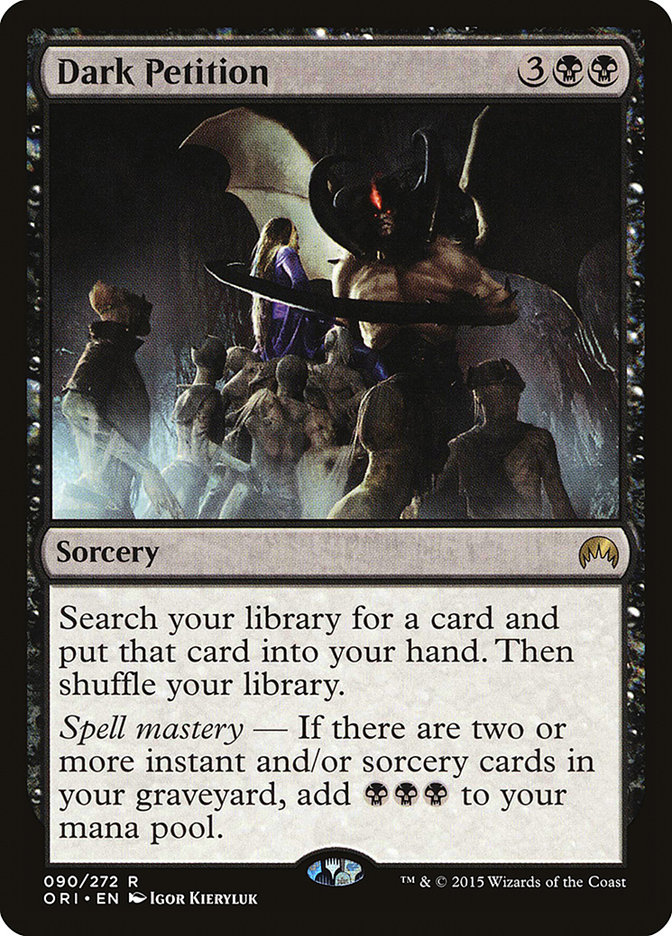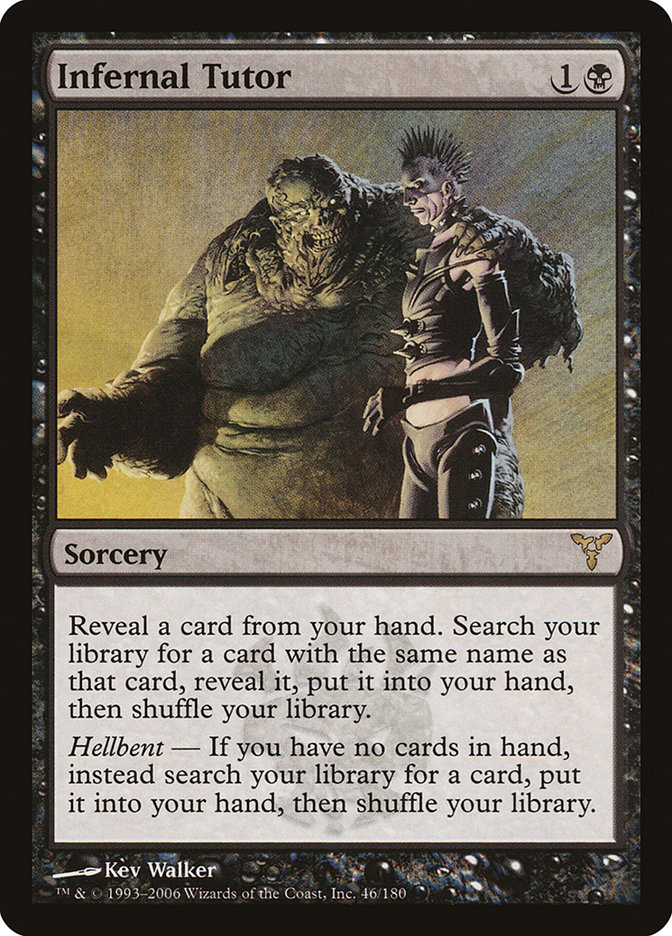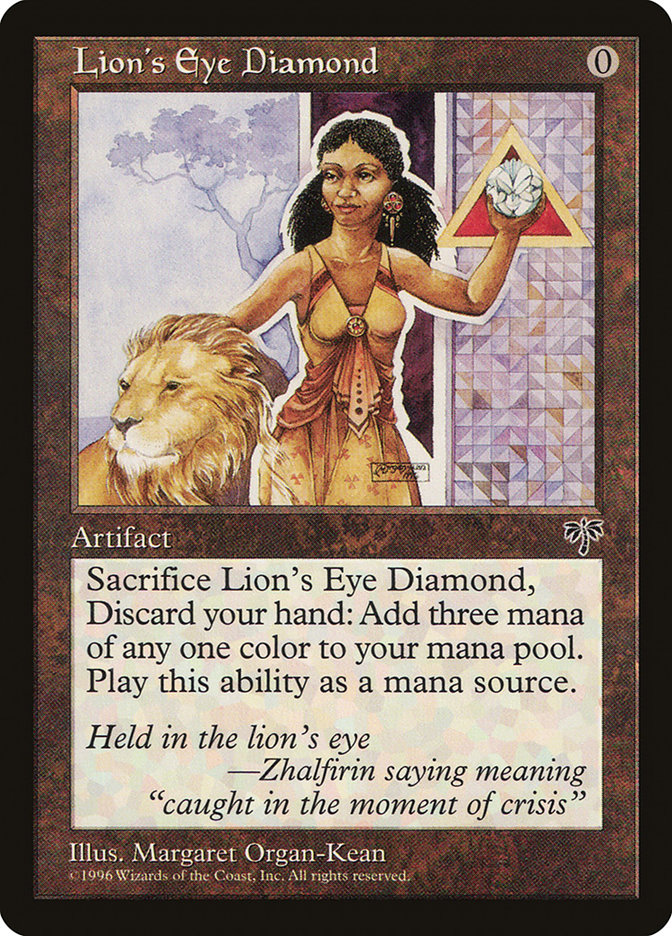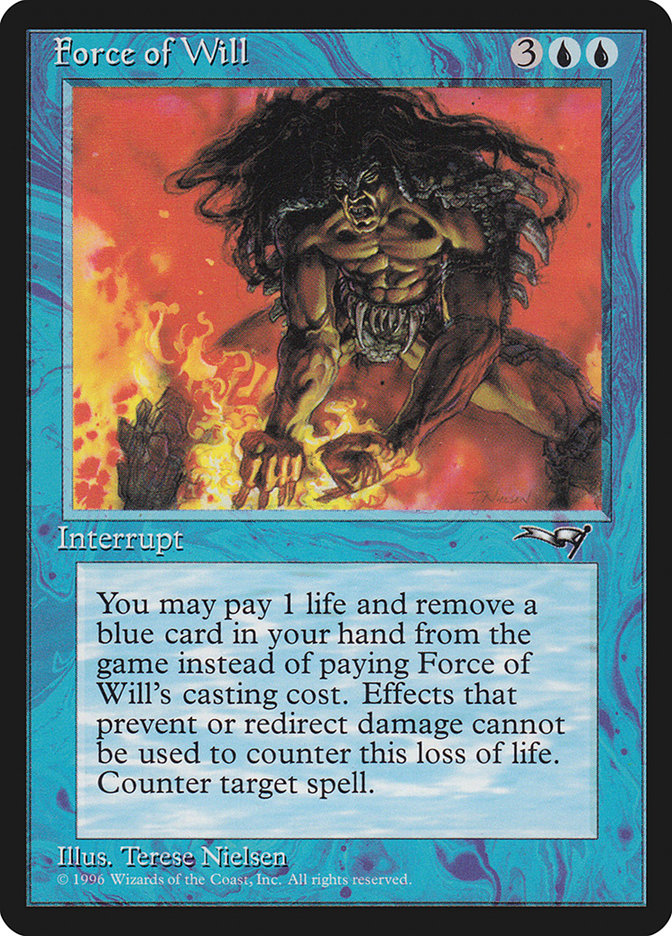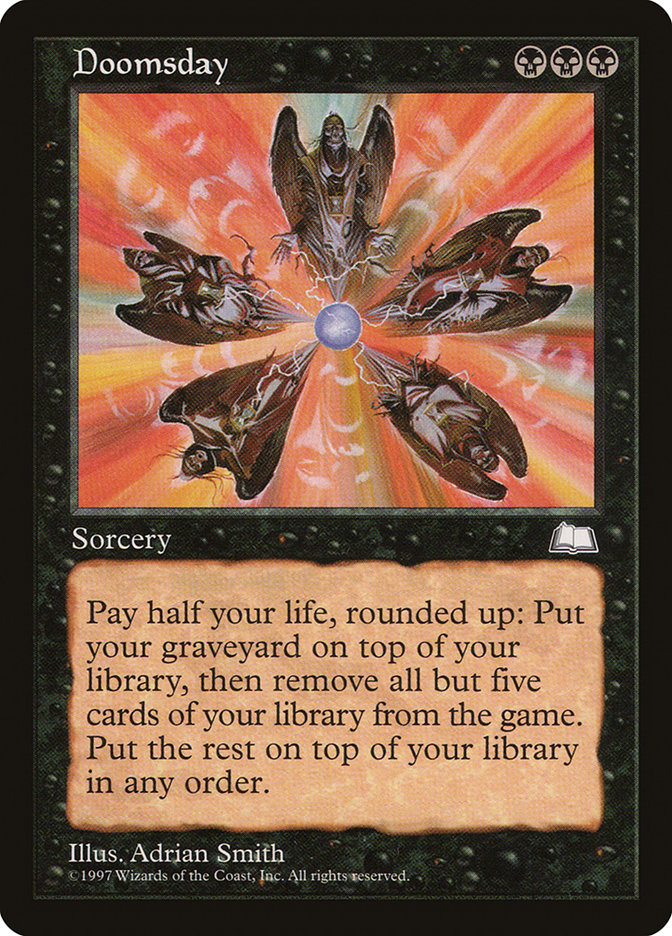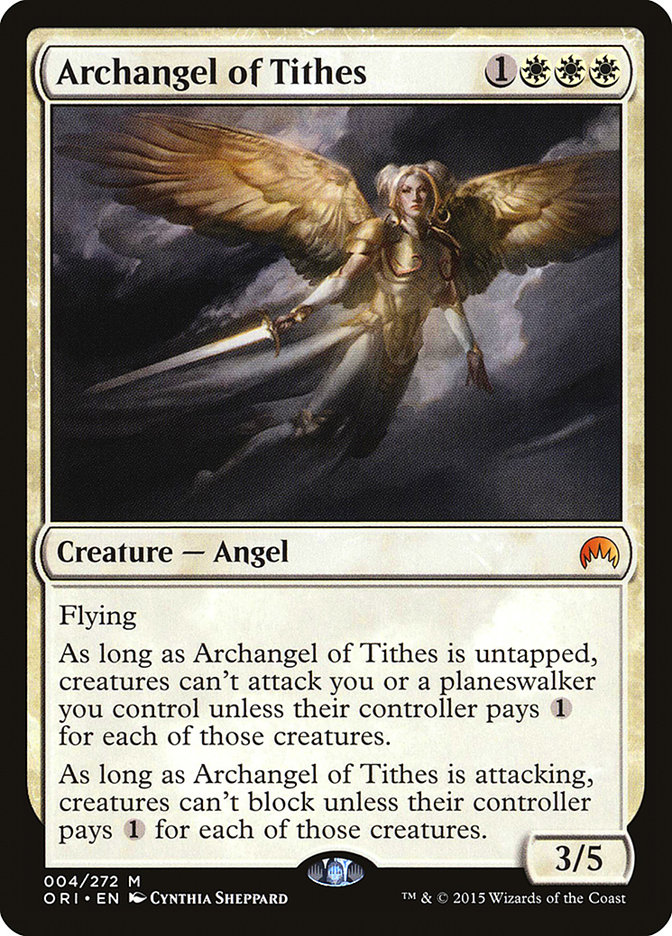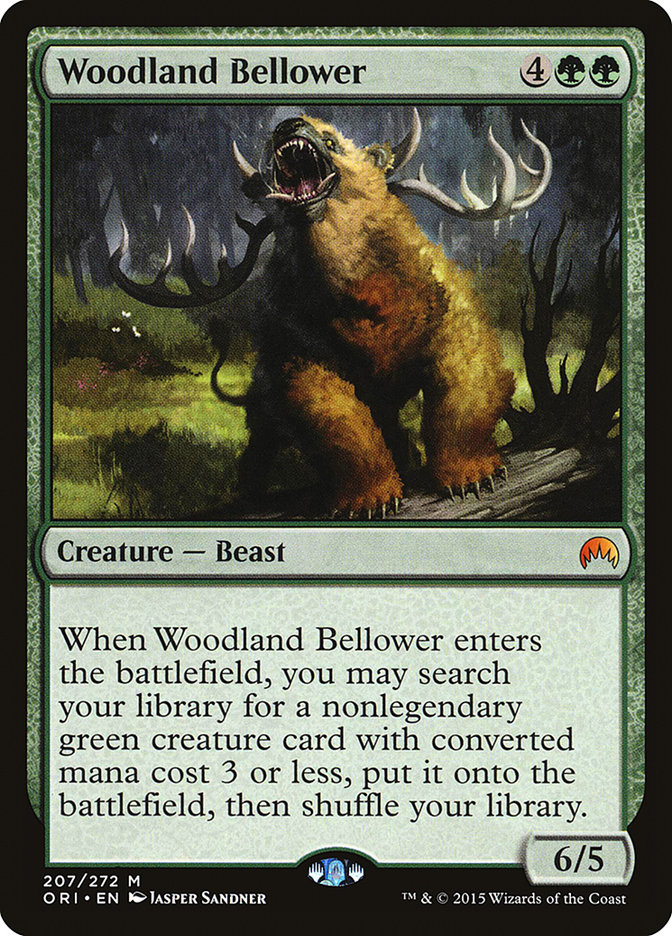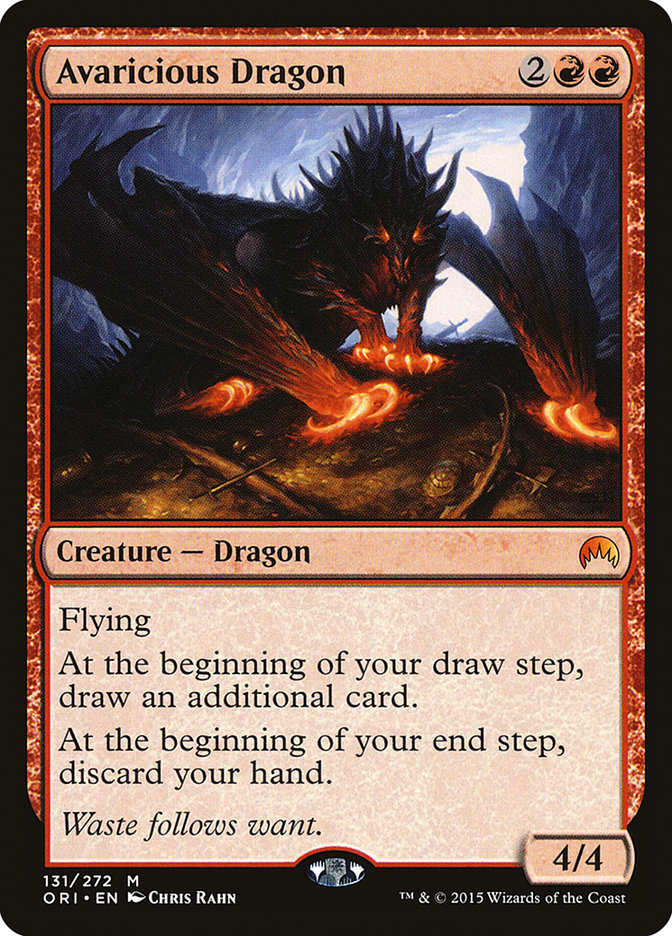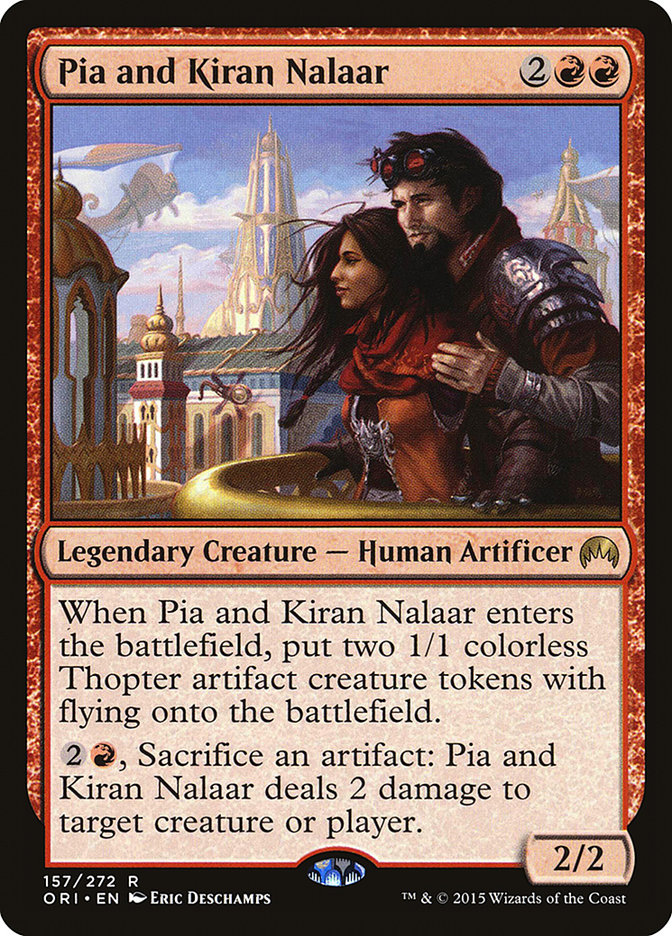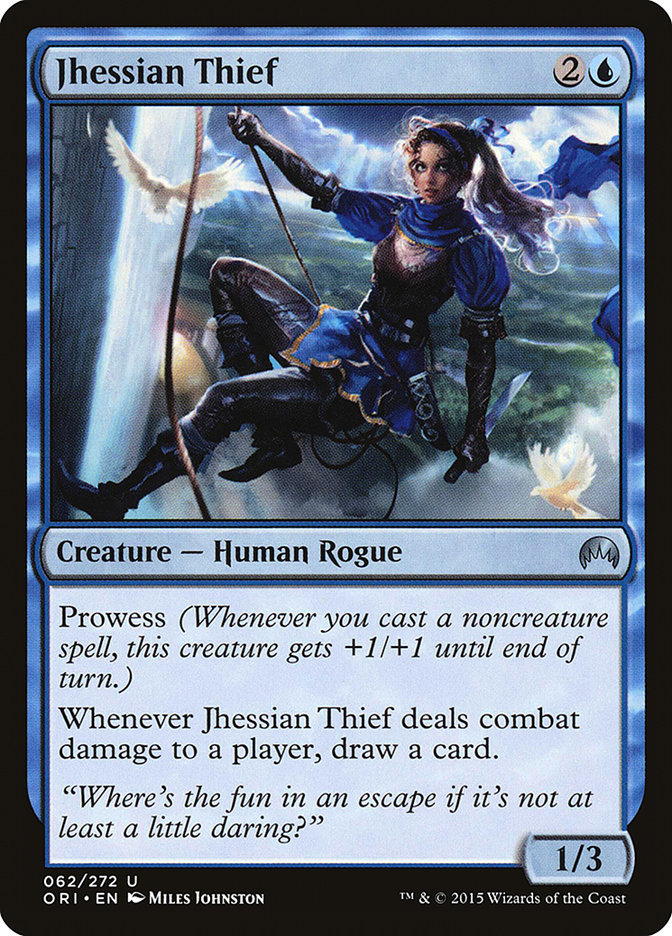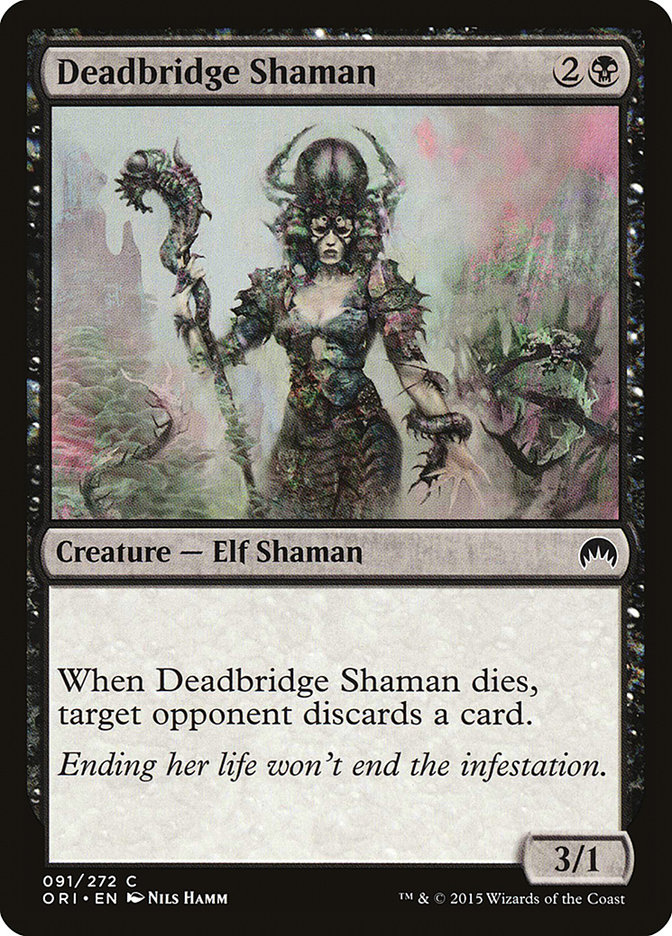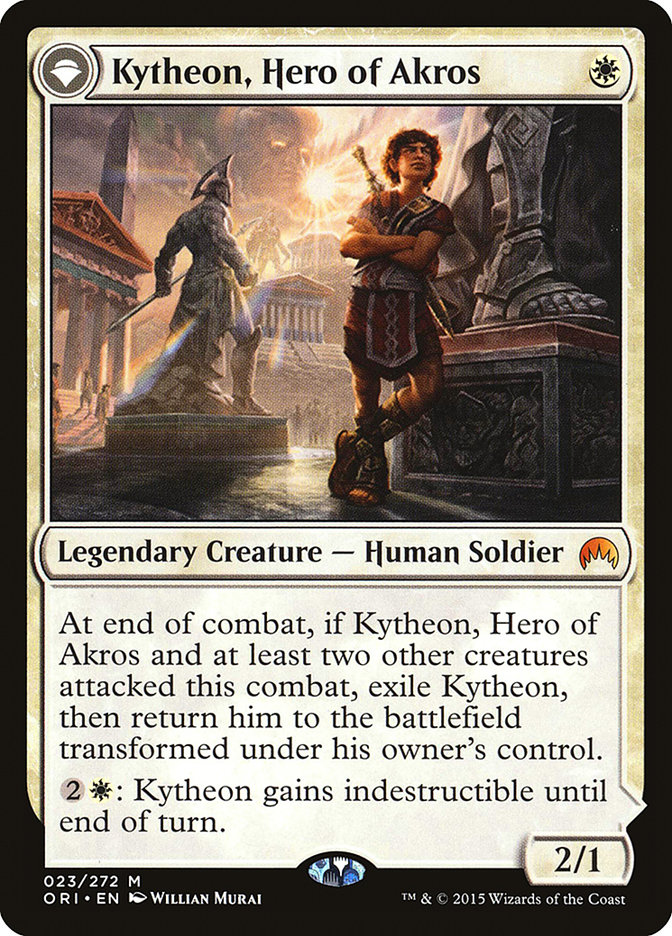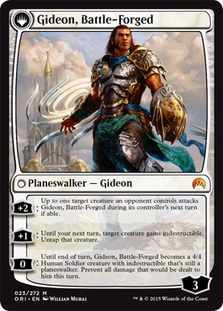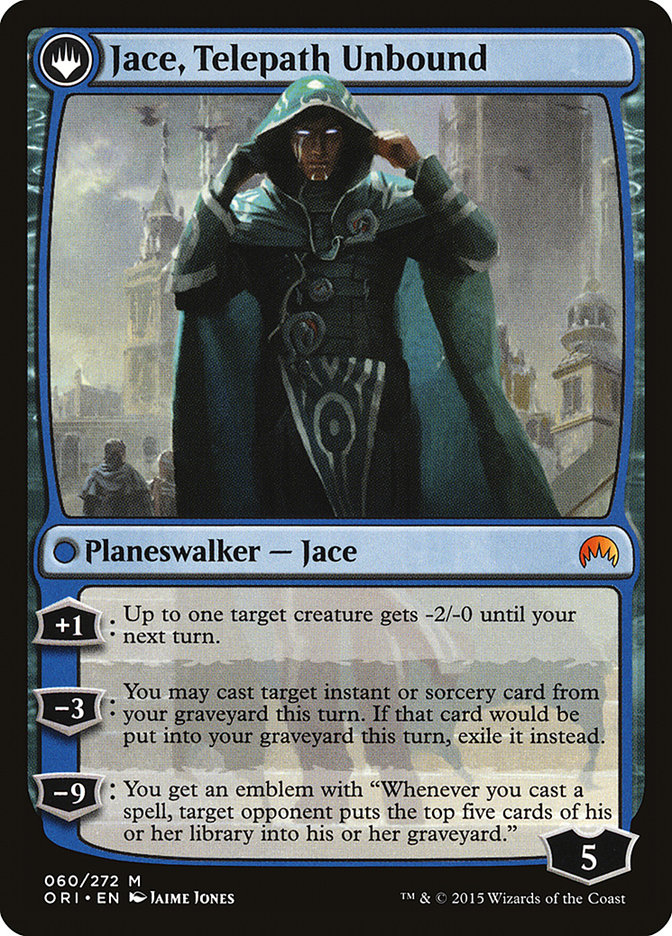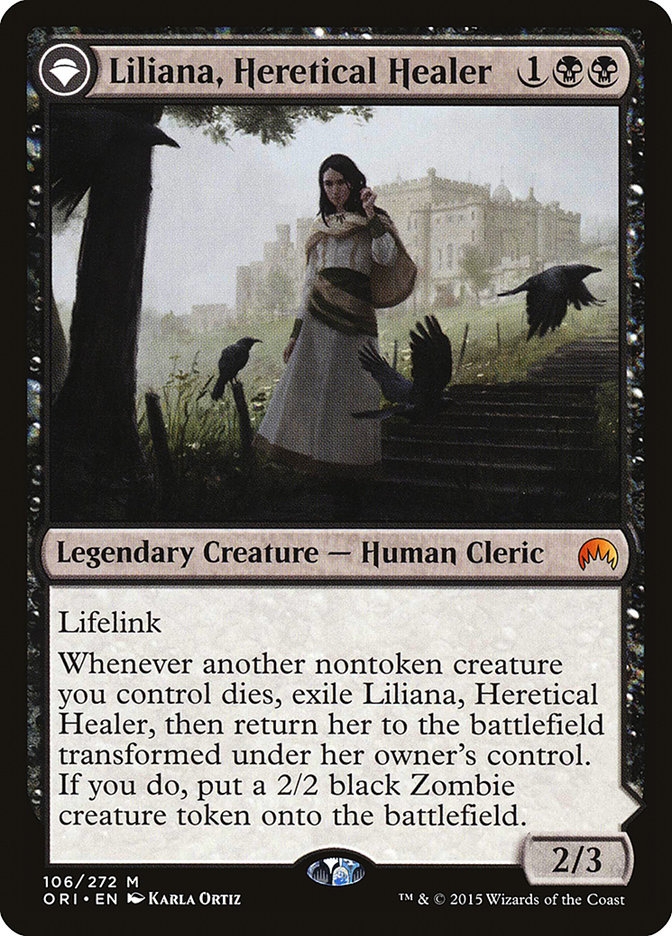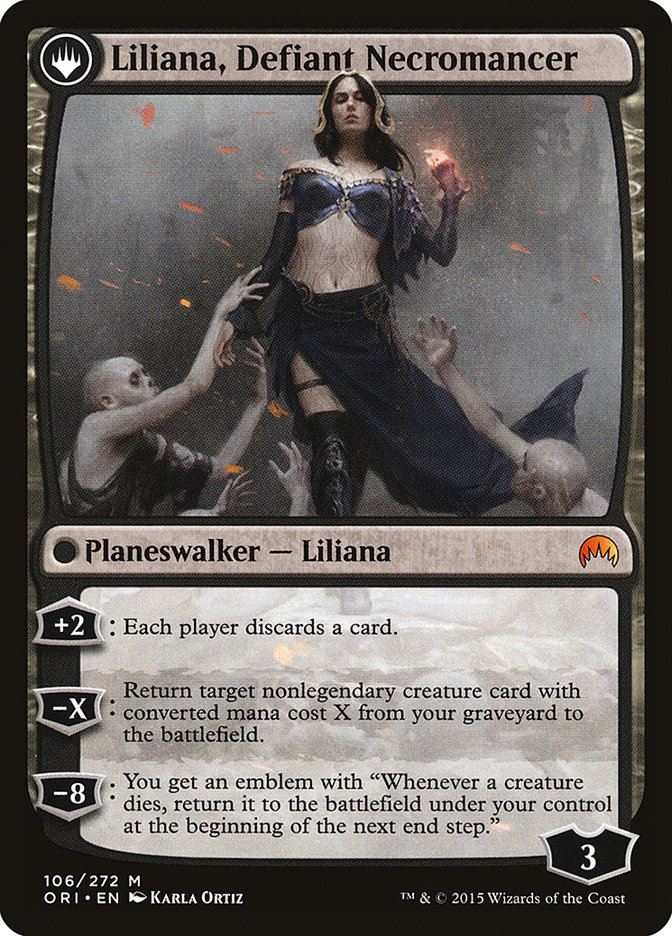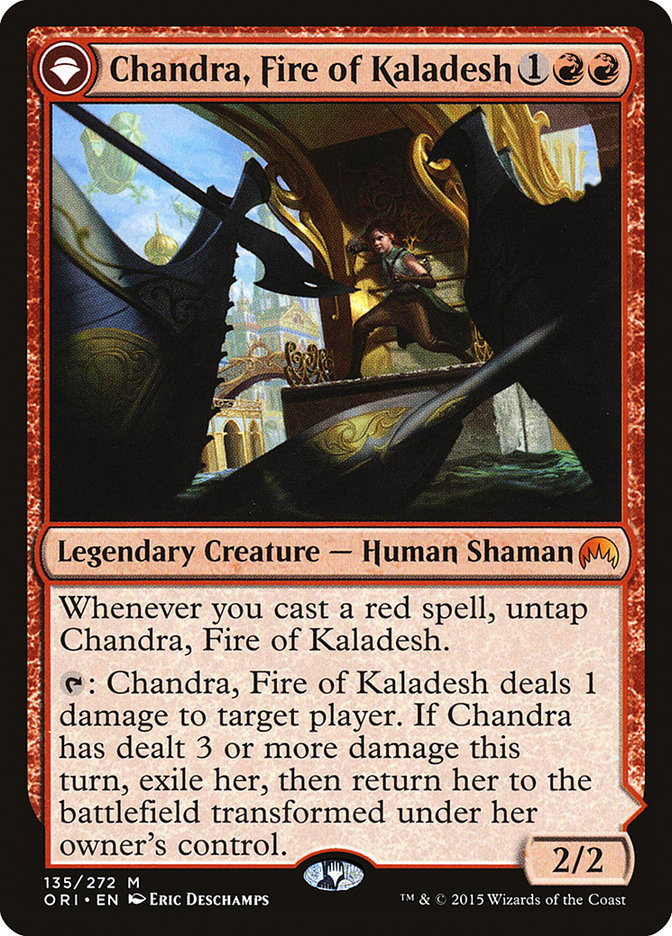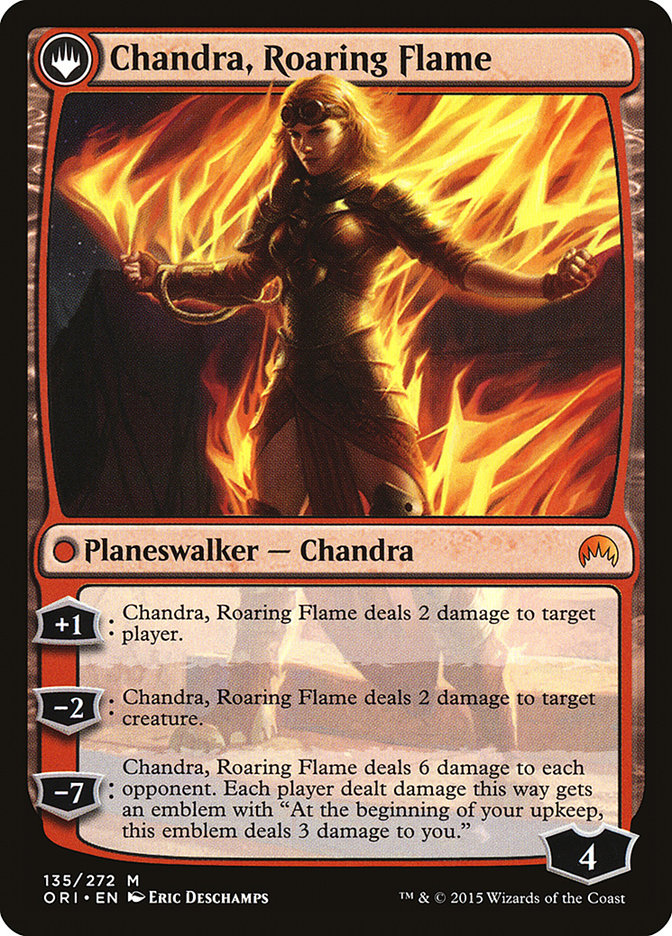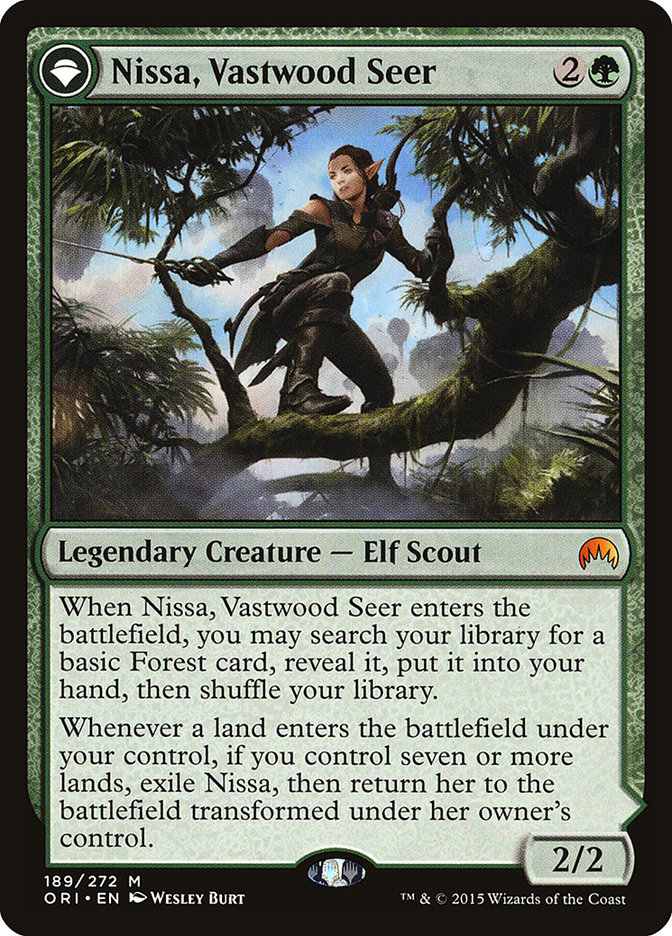Magic Origins is the last Core Set for the foreseeable future, and the R&D team has not held back on it. We only have about half of the set right now and there are already more cards to talk about than the average Core Set had in all 272 cards.
Nowhere better to dive into this than with what is easily my favorite card in the set.
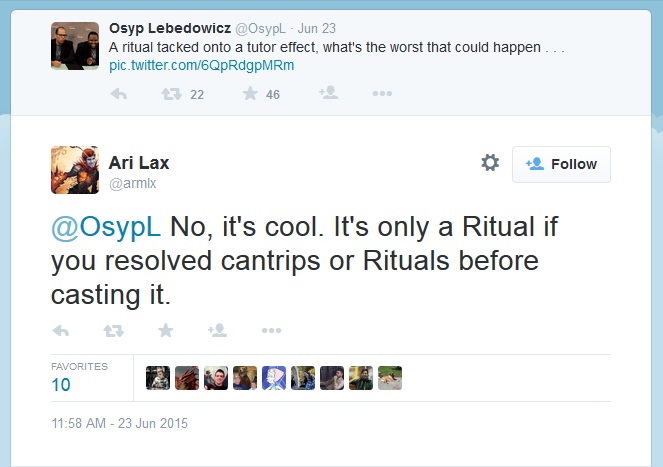
I thought the days of these kinds of cards were behind us, so this is a real pleasant surprise. The last time Wizards printed a relevant Storm card was… Innistrad, with Past in Flames? I guess Goblin Electromancer is a thing, but it’s conditional in application to Modern. I don’t expect this card to be a Modern player as all of the Rituals being red in that format doesn’t line up well with it, but this is a card that might actually change Storm in Legacy. No promises, but it opens up a lot of new options.
The current Legacy Storm engine has been mostly unchanged for quite a few years, and for fairly good reasons. You get to play four Demonic Tutor, four Black Lotus and the only drawback is that you have to play them both!
Well, not the only drawback. When Infernal Tutor is on the stack you can’t have cards in hand. This doesn’t really affect your Rituals or cantrips as those are all cast up front, but it limits your disruption options.
Storm can’t play Force of Will because it can’t use it to protect its crucial card at the moment it matters most. Duress is still great and Silence has its own benefits, but there’s something to be said for the fact that every other Legacy combo deck plays Force of Will instead of other options. There’s just a kind of flexibility that it offers that other cards don’t. You can answer their threat, you can answer their answer, you can force them to commit mana or an extra card to their Force of Will instead of just seeing a hand of three counters and knowing you have to clear all of them to win.
Of course this does cut you off of playing Lion’s Eye Diamond for the most part, which is a big hit. The next best Ritual is probably Rain of Filth, which pushes the deck significantly slower and likely reduces your Ritual density as the card is terrible in multiples. You also lose Ad Nauseam with so many five drops in your deck, meaning your deck has to turn to Empty the Warrens as your quick-and-dirty kill condition (though Force of Will is pretty good at handling typical Empty the Warrens answers like Terminus). Your typical Tutor-chain kills and whatnot still work fine, especially as Dark Petition into Cabal Ritual still nets a mana Infernal Tutor style. Spell Mastery forces your deck to be graveyard-based to some extent, making the incidental Tormod’s Crypt that people love to board in against Storm actually matter because it can cost you three mana. I don’t necessarily think that in the dark this is going to be the better version of Storm, but there are likely specific slower metagames where graveyard hate is marginal and the ability to Force a Counterbalance is huge, or where you want to play a long game and lead on Dark Petition with the threat of finding Tendrils of Agony off a full hand.
Another good anecdote here: Vintage Storm is still split on Duress and Force of Will depending on the metagame even though it gets to play straight up Tutors. Duress or Silence still have edges like not costing two physical cards or being able to proactively add to Storm count that sometimes matter more than Force of Will.
Some other marginal facts about the card that are worth noting for this kind of design:
- You can just use this as a normal Tutor to assemble more backup as part of a combo chain. Similar to the line where you lead on Dark Petition to find Tendrils, you can Dark Petition to find Duress or Force of Will before using the mana to keep on moving down the chain. I would say that it may even be worth having a maindeck removal spell, but I can’t figure out what permanent I need to remove that actually still lets me cast my five-drop sorcery before killing it.
- Dark Petition is really nice with cost reduction. I messed around with Grim Monolith–Helm of Awakening shells when writing my Building For A Banned List article last year, which were actually pretty interesting. The only problem is that adding permanents adds another axis to interact with the deck and makes it a bit harder to achieve Spell Mastery.
- Dropping Ad Nauseam means the deck can Dig through Time. Oh, and Rain of Filth fuels Delve. Wait, I want this now, can we make it a thing?
Lands (15)
Spells (45)

Yeah… so basically stock Storm, shift the disruption a bit, and add Dig Through Time where the extra Rituals are missing. Trust me that the differences are bigger than they look on paper. Note that there are only three Force of Will as it is unlikely you have the cards in hand to support two during a kill and that Pact of Negation is there as the best possible disruption spell to Petition for on the kill turn.
Of course, there is another deck that doesn’t mind a Tutor and conveniently has a kill spell that costs BBB…
Burning Wish already exists as a really similar effect, but it’s worth thinking about if cutting a color adds anything. You can Wish the turn before you Doomsday and Lion’s Eye Diamond with Wish when you have Sensei’s Divining Top in play or are passing the turn, but on the flipside you no longer need full on WUBR to Silence plus combo sometimes. I don’t think this solves the fundamental issue with the deck where you have to balance your cantrip use against using them as storm fuel after stacking your deck, but it might make the core a little less unstable.
On a much less exciting note, I actually think this card is actually good enough in the fair sense for Standard. Diabolic Tutor was fine when you had a deck that made a million mana with Cabal Coffers to support it, and this basically takes away the needing a million mana part. You just need a spell you want to spend BBB on to Tutor for, which is easier than it sounds. Ugin, the Spirit Dragon might be a bit excessive to try and cast there, but at the least this is likely a fine one- or two-of over the second copy of an overly clunky finisher in some decks and might even been a good four-of if the right cards are printed. Languish and Crux of Fate are two parts of the equation here, you just need something analogous to Mind Sludge to find against control decks and something like Riptide Replicator to close with.
This card seems exceptional given the current state of Magic design. I’ve talked a lot about being able to break serve and regain the initiative over the last couple of years, and this is a card that really helps put you into positions where you are casting two spells before your opponent on the draw. Now may not be time, as people are jamming tri-colored spells all over the place that make double white hard to access early and there are 3/3 Deathtouch creatures everywhere, but I expect this card to at one point over the next fifteen months to be the absolute reason to play a section of the format.
Also worth noting: this card’s value goes way up as Relic Seeker and Kytheon’s Irregulars get better to support a more midrangey white deck. The latter gets a huge boost when Stoke the Flames goes, and the former wants whatever Zendikar has to offer. It’s kind of sad for Knight that this means Elspeth, Sun’s Champion has to leave, but that also is another checkmark for both of these cards.
Somewhat linked to Knight of the White Orchid, this card is solid. As long as Stoke the Flames and Hordeling Outburst are the norm out of red decks it absolutely shuts them down, it’s sized to tangle with Siege Rhino and Mantis Rider, and it flies over Deathmist Raptor. It won’t dominate the format, as it is always going to be a no-value four-drop that doesn’t hit for a really significant amount in a format of Hero’s Downfalls and Abzan Charms for days, but it’s a fine midgame drop for decks that can support the triple-white cost as long as the rest of their deck solves the issue of playing against black cards.
If you sacrifice this with the trigger on the stack, you get a Zombie token. Value.
Just finding a Deathmist Raptor or Savage Knuckleblade with this card is nice, but it’s not quite flashy enough for me. Broodmate Dragon and Wingmate Roc are so great because they fly, and I think this card needs to dig a little deeper to bring similar value to the table. The obvious one is Reclamation Sage to build a kind of Nekrataal. If there is a creature that brings a Fight effect to the table printed soon, that’s another big plus. The real winner would be something like Fierce Empath or Eternal Witness that allows you to chain Bellowers. I haven’t found one of those yet in Standard, but it’s something I have tabbed away to notice for the next four sets while this card is in the format.
I have real issues with this card. Just being a 4/4 flier in play is really good, so drawing two cards a turn after that point feels a bit like extraneous value. I would obviously take it if there was no cost involved, but the fact that you have to discard your hand on your end step means this can never be your lead-off threat. I expect this to see almost no play, especially with Thunderbreak Regent in the same format.
Now this four drop on the other hand…
It’s not that hard to figure this one out. This card isn’t quite Siege-Gang Commander, but four mana is also a significant drop down from five in terms of what phase of the game your card is resolving in. It’s four power with both evasion and upside in a package that is good against Hero’s Downfall. Depending on the metagame or your other cards a big fat Dragon might just be better, but it’s definitely worth considering. Note that my default thought is that I would rather have Thunderbreak Regent in Mono-Red if I have Hordeling Outburst, as threat diversity against Drown in Sorrow seems really important, though if you want to go full psycho with Impact Tremors be my guest. Also note that this is probably just good enough in a normal midrange deck and doesn’t have to be slotted into the red aggro shell.
Don’t worry about trying to combo people with this card. It’s really difficult and probably not worth it relative to something like Meditate. Even if you are doing something silly like playing Reset, this is probably a sideboard option at best: it isn’t even great mid-combo since it resets your opponent’s Force of Will count. This is just a really nicely-broken fair card.
One of the best Timetwister plays in Vintage is the old Mox, Mox, land, Twister on the play. You are up three cards and your opponent is forced to “keep” a random seven. There are a lot of decks in Modern and Legacy that are really good at dumping their hand into play and generating three mana. I doubt the old turn-one Timetwister is a real thing, but it seems easy enough to shove on turn two. These aren’t decks that really are trying to do anything after drawing seven to keep going, they just want to play 2U draw seven.
Which decks are these? You have the obvious Affinity and Elves possibilities, but the ones I’m most excited for in Legacy involve Ancient Tomb, Chalice of the Voice, and Chrome Mox or Mox Diamond. It feels real nice to have locked your opponent out of some of the cards you are forcing them to draw and it’s actually realistic to turn one it with your best draws in those decks.
I’m not an expert in the kinds of cards these decks have access or what the best lock pieces are now (Back to Basics?), but I’m imaging something similar to the old-school Sea Stompy decks. Only no Sea Drakes, which is probably just trash compared to what you can pull off these days. Hell, if Spawnwrithe is good enough in the green lists maybe you want Jeskai Infiltrator.
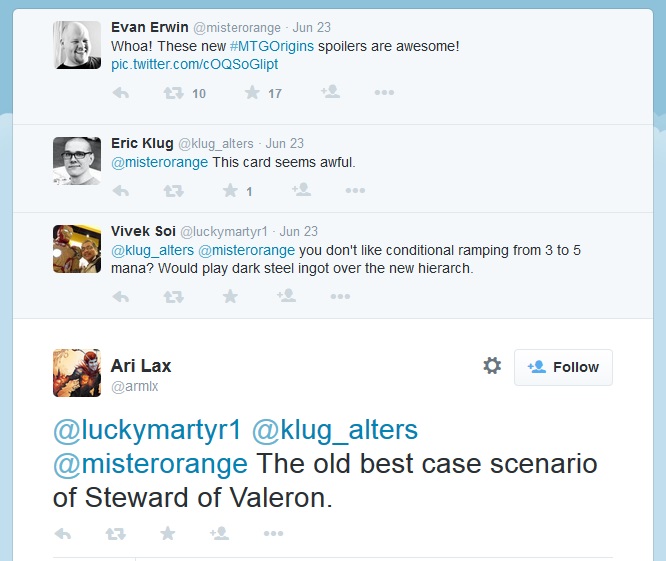
Just had to fire that one off for editor tilt value when everyone in the comments ends up raging out about how a world without Elvish Mystic isn’t one worth living in.
This card is probably the best Prowess creature spoiled and probably playable, but I want to go on a mini-rant for a second here.
Prowess is a really cool mechanic for what WotC wants it to do (make blue have more combat interaction in Limited), but keeping it around long-term just feels dangerous. The mechanic is still very close to what is known as one of the most broken mechanics ever, and while it is possible Monastery Swiftspear was just an outlier it seems like even with just Young Pyromancer and that card we are really close to Tempo Storm. One missing piece and you suddenly have a tempo deck that not only plays the disruptive game well, it just goes off if you aren’t trying to stop it. The big issue here is that unlike a traditional combo deck, it’s really easy to be all fair cards here and be a fine Magic deck when disrupted and super broken when not.
Jhessian Thief is definitely on the right side of Constructed playable and not too scary, but it’s a relatively new mechanic and like all new mechanics the line between good and too good is not well defined and easy to cross. We saw it with Sword of Fire and Ice and equipment, Jace, the Mind Sculptor and planeswalkers, a bunch of the Delve cards in Khans of Tarkir, and many other things. I don’t think it’s impossible for the mechanic to stay around and not cause harm, but there is a very precise calibration between “This is a problem” and “This is boring” that has to be worked with here.
Spoiled this last weekend at Grand Prix Singapore, this was the second card in the set after Dark Petition to make me actually say wow when I saw it existed.
I barely know where to start with this thing. All I know is that a two mana Man-o’-War is really good, and an instant Man-o’-War is really good, and that a double-blue two-drop is really good as long as Thassa, God of the Sea is around. All I’ve figure out is that you probably want evasive creatures to force races that you can punish here. Fortunately, Thassa is great at that.
My vote so far for least flashy card that actually ends up making a splash. The rate isn’t great up front, but it’s a fine rate if it ends up being a two-for-one.
This is my other vote for the least-flashy-but-good award. This one might just be a personal bias due to the association with Maniacal Rage, but if the +2/+1 is pushing your creatures into a relevant size bracket, it’s really nice to be able to do that without actually committing a card to it. It’s also a way to trigger Prowess and conveniently curves pretty well off of a turn-one Monastery Swiftspear for a four-power attack on turn two.
The Flip Planeswalkers
Chas Andres had a really good comment in his Dragons of Tarkir retrospective: “When in doubt, opt for the cheaper cards.”
Oh wait, all five of these planeswalkers cost three or less mana. Hmm, let’s try again.
While I’m not entirely sure whether these are closer to creatures with big upside or actual planeswalkers, there are a few parameters I’m assuming are relevant just based on looking at similar past cards that have the drawback of being Legendary or planeswalkers.
- Does the card quickly take over the game if unopposed? Mono-Blue Devotion played four Thassa, God of the Sea because the first one just being in play was usually enough to win.
- Do additional copies have value? Jace, Architect of Thought conveniently chained -2s into extra copies to replace the one you were burning away to draw cards. Liliana of the Veil going -2 on one turn followed by another one for -2 is pretty backbreaking as the decks with the card are often just looking to exchange resources, and you can always bin extras to the +1. Even further back, Garruk Wildspeaker would often just make Beasts until it died, at which point the next one made more Beasts.
- Does the relevant part of the card (read: planeswalker) come online immediately? Being immediately useful with a repeatable effect is huge, basically turning your card into a spell with upside if it sticks around.
- Is the card a strict upgrade? The perfect example of this was way back in Kamigawa Standard. Why play basic Forest when you could have one Okina, Temple to the Grandfathers that is just a better card at no cost? There’s no Blood Moon or Wasteland to punish you.
Does Gideon win the game if unopposed? A 4/4 Indestructible isn’t bad, but it doesn’t create incremental advantage like the typical planeswalker that ends the game does, which makes me skeptical of it on that axis. Gideon Jura was at its best when the +2 and -2 locked down your opponent’s board, not when it was a 3WW 6/6.
Do additional copies have value? They are actually actively bad. The second Kytheon makes flipping the first much more difficult as you are short one card that might go towards the Battalion trigger. If you have a Gideon in play, Kytheon is a fine creature, but it’s still just a 2/1 at a later stage of the game. As we have seen with Soldier of the Pantheon being a role-player at best, a 2/1 that is hard to kill is just not properly positioned for current Magic.
Does the relevant part of the card come online immediately? Absolutely not.
So Gideon fails on all three of those metrics. It does succeed on the last one: it’s a pure upgrade on Savannah Lions. Being Gideon is certainly a bigger upside than Protection from Dragons or whatever else they are handing out for free these days, so Kytheon is likely the best White 2/1 for one you can show up with. You might not be able to get away with a full four just because additional copies clash with each other, but at the least the first two copies are sure to be better and the third isn’t likely to be much worse.
The big hurdle is actually wanting a Savannah Lions in this format. We have a lot of Savannah Lions upgrades in Standard that don’t see play right now. There was a White Weenie deck towards the end of last season that was interesting, but didn’t pan out then when the format was significantly less punishing to dorky creatures due to a lower concentration of Fleecemane Lion, Courser of Kruphix, and Hordeling Outburst among other cards.
Kytheon is obviously a pushed card, but there’s a good chance it’s the wrong card for the wrong time now.
Not online immediately. One test failed.
Merfolk Looter is not at par for Constructed right now. Next test failed.
You can loot away extra copies if you haven’t flipped Jace, but once you have Jace, Telepath Unbound in play, the creature side of Jace is a 0/2 that can only loot once before replacing your planeswalker. Not ideal.
So the big question I have is whether or not Jace is good enough to take over a board. The echoes of Snapcaster Mage certainly suggest something good, but a big part of Snapcaster Mage was the immediate additional value. As odd as it is to say, the Coral Merfolk might be better than what Jace represents, which appears to just be another Flashback.
If Jace is going to be good, my guess is that it will involve setting up some kind of chain where you are using it as a slower, more flexible, cheaper Restock that self-rebuys, like Snapcaster Mage does with Cryptic Command or Kolaghan’s Command. There’s a convenient pattern of play Jace, flip it, -3, +1, -3 where it gains value then puts itself into your graveyard on the same turn you are flashing back a spell you can use to rebuy it. The other possibilities are that using Jace to rebuy card draw is enough of a “chain” to count, or that Merfolk Looter is good enough with Delve in the format to also manage whether you want your Jace to be a creature or planeswalker. It feels like there’s something here that is worth finding the card a home, but it might be a while before everything lines up for it to happen.
Multiple Lilianas work together pretty well. The second one flips the first one and still advances your board when the 2/2 Zombie is made.
Depending on the matchup, a 2/3 Lifelink creature might actually be a reasonable card. Liliana isn’t always going to be all upside on a card you would already play, but I think a lot of the matchups where you might not want the grindier planeswalker, it’s going to just be a bonus on the better part of Vampire Nighthawk.
I can easily see Liliana taking over a game. Adding loyalty to Bottomless Pit is an effect Liliana of the Veil has shown us is powerful. There’s also the parallel of both having a minus ability that is self-protecting. The difference here is that instead of building towards a locking ultimate once you have established the discard lock, this Liliana builds towards a direct kill. The difference is that this Liliana has actual constraints on making the minus good beyond your opponent’s creatures not having Persist. You need high-impact, low-cost creatures to return that can prevent future attacks. It also leaves you more exposed to interaction, which definitely leads to better play patterns than leaving your opponent with nothing available to play or hold cards.
Liliana can trigger immediately, with the key word there being ‘can.’ You need to do a little bit of work to make sure a creature dies to begin with, but once that’s set you are in business.
A lot of people have pushed towards this last point as it’s the clear glaring issue and I’m not adding a lot by going further down that road. I really think the big issue people are ignoring is figuring out how to mesh that with actually good creatures that you want to –X back onto the battlefield. The Collected Company idea seems really good, both to find the second Liliana for the easy flip and because the Megamorph duo of Den Protect and Deathmist Raptor provides good sacrifice fodder and a good creature to rebuy. My guess is that the immediate application of Liliana will be mostly fair and not engine-based as the sacrifice effect isn’t there yet in Standard, but that could easily change.
I was really, really pumped about this card on the first few readthroughs. Then I applied my metrics and have become less and less impressed. Let’s start with the good up front.
The second copy of Chandra is pretty solid. You can still run the attack, play a red spell, ping and flip even if the red spell is the second Chandra. This leaves you with one of both sides in play, and you can just time your pings to not flip.
Now all the bad.
Chandra can’t enter the battlefield and flip into the relevant side immediately. Summoning sickness is still an issue, and even with Haste, casting Chandra and another spell in the same turn is an issue.
The flip side is kind of just a Phantom Warrior. I guess you technically deal 18 damage after four turns with Chandra with the plan of three damage to flip, three +1s, and an ultimate for six plus three, but that brings me to my next point.
Would you play the following card in Constructed:
1RR
Menace
5/2
I don’t think I would immediately consider that card great. The difference between that card and Chandra, Fire of Kaladesh is fairly minor, with Chandra’s pinger evasion being a little better at handling blockers.
If I’m casting Chandra, I’m only really excited if the -2 ability is getting value. Unfortunately the size of creatures right now is well above the point where things die to a Shock. Heck, if that’s the standard, doesn’t Chandra just die to one too on the front side?
Four for four.
Borderland Ranger or Civic Wayfinder has seen Constructed play on multiple occasions. Nissa is marginally worse at that job for a huge upside.
You can immediately play your land and flip Nissa to get a planeswalker activation.
Extra Nissas aren’t as good as they could be, buuuutttt…
+1: Reveal the top card of your library. If it’s a land card, put it onto the battlefield. Otherwise, put it into your hand.
-2: Put a legendary 4/4 green Elemental creature token named Ashaya, the Awoken World on to the battlefield.
Also known as +1: Draw a card and -2: Make a relevant token.
This is a planeswalker I would legitimately pay five mana for. Not using counters to gain card advantage is something that is already mostly relegated to higher-cost planeswalkers, and all of the lower-cost ones that have that effect have been solidly Constructed playable with the exception of Nissa Revane.
So we have a solid low-end effect that translates into a highly-impactful late-game threat as the game progresses. That’s just straight up good. Nissa is the real deal and probably the only one of these planeswalkers that is just straight forwardly powerful with minimal expended effort.
The most important part is these are all unique and interesting cards. There aren’t really any Baneslayer Angels or Thundermaw Hellkites where you just look at the card and go “Well, that’s a great rate,” with the exception of Exquisite Firecraft which is still a fairly dynamic spell for metagame purposes. The powerful cards so far are all unique and promote interesting deckbuilding. For a Core Set, that’s absolutely astonishing. Despite my undying love for Magic 2013 in Limited (and Sixth Edition in the basic land selection game), I’m willing to bet that when I look back, Magic Origins will be my favorite Core Set for Constructed without any real competition.

